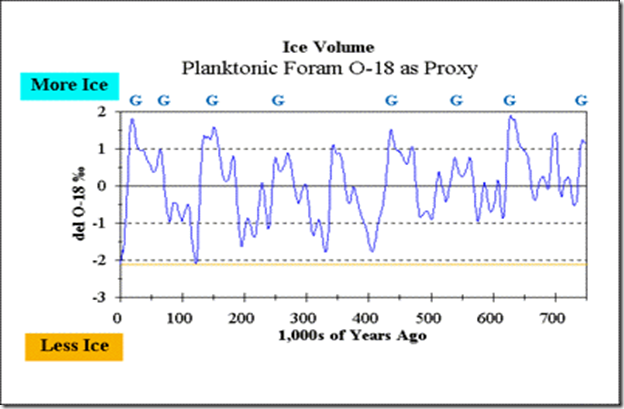
Graphics from here….. derived from here…. http://www.scotese.com/climate.htm
What does this mean?
 http://www.museum.state.il.us/exhibits/ice_ages/
http://www.museum.state.il.us/exhibits/ice_ages/
Does or would the continental drift effect our conclusions?
Food for thought. And, I thought they’d be useful to have around! ![]()

When did the Drake Passage open? 40M years ago?
Therein abouts according to the experts…….
The Carboniferous was very good time. Here in Newcastle we’re still digging it up to ship to China. I can’t remember when we last had 3% unemployment in this town. Does this help?
By amazing coincidence, 40M years ago is exactly when temps started going down down down
Yes, amazing coincidence! It seems about the time CO2 took over as a primary driver of our climate! 😉
Which also created conditions for C4 grasses to proliferate………….
…which lowered CO2 levels even more
CO2 wasn’t driving global warming or cooling back then…….. 😉
lol, well, maybe just evil burnt fuel CO2!!! Cause that’s way different than regular CO2!
it’s truck day….on my way to the mainland….in the fog!
Do you have Pontoons on that truck?
Not yet….but tomorrow it will have a new computer!
And we’re all freezing…
It means when the plates realign in a few million years to allow better ocean mixing the globe will start warming up.
People do not seem to realize the planet has been cooling for 38 to 40MY.
The glaciation became even more extreme when the Isthmus formed between North and South America. That will be the first location to open up unless the southern plate rotates into the southern edge of the northern plate. That would give better circulation in the Southern Hemisphere but would probably cool the north even further.
It simply amazes me that 1) people think CO2 is a player in any of this, and 2) that the earth should and has been in a more or less stable state.
CO2 is a player, in the stratosphere that is.
hmm….. care to comment? http://www.metoffice.gov.uk/hadobs/hadat/images/update_images/global_upper_air.png
I would comment but some can not see there is NO evidence that CO2 is more than a bit player and more likely a observer from the side lines.
CO2 is very dependent on temperature for its existence.
I need to amend that statement because there is no real world evidence what the real CO2 level is or was. The closest we have are guesses based on Leaf Stromata, the rest is WAG.
Of course we should not even discuss the reliability of the current methods used to determine Global CO2 levels:
I always liked that song….. 🙂
That first graph above, which is srtll spooking on some websites, is a bad fabrication. If we follow the sources we can see that the data for temperature are coming from Christopher R. Scotese who is investigating tectonic plate movement over the last billions of
years. So his involvement in climatology is probably very limited. He published a rough graph of global temperatures over a period of the last 2 billion years on his website.
The rise of the present time has just been cut out by the creators. But mostly important: The time scale is not linear. Or do you see any time data there? Look yourself when the periods start and end. This graph is therefore inappropriate to use for a comparison with a linear graph of CO2 concentration, even if you’re trying to squeeze it in.
The data for atmospheric CO2 are taken from another study, A REVISED MODEL OF ATMOSPHERIC CO2 OVER PHANEROZOIC TIME [the last 542 million years], ROBERT A. BERNER and ZAVARETH KOTHAVALA, Department of Geology and Geophysics, Yale University.
Overlapping a non-linear graph with one line of another linear graph has the informative value = zero.
So here a graph which shows the real correlation between CO2 and temperature over the last 550 million years.
And as scientists can better track the more recent time, here a graph of the last 400,000 years.
Temperature change (blue) and carbon dioxide change (red)
=> NOAA – Temperature change and carbon dioxide change
Some people have problems with the x-axis scale
Mrsircharles – so you’re saying temperatures have not been falling, rather they’d been falling.
Umm Mrsir…. there is a time scale there. lol, it just isn’t in years. The author probably assumed the readers understood when things like the Cambrian and Jurassic periods were.
BTW, just so you know, your NOAA graph shows CO2 lagging temps in several spots on the graph…..
mrsircharles, all four scales are linear, I believe you’ve misread the graph in that respect entirely.
The x-axis top scale is labelled at irregular (but still linearly scaled) intervals.
What figure are you proposing for the “Average Global Temperature” which you claim is “chopped” from that graph?
Are you getting confused between an absolute measure of “Average Global Temperature” which the graph you criticise purports to show, and relative temperature anomaly, which the two “Hockey Stick” graphs you reference actually deal with?
I’m not trying to score points specifically, but you seem to be conflating several issues and coming to odd conclusions.
Incidentally, I’d criticise the graph itself on the basis that it seems to show uncertainty in atmospheric CO2 with the shaded region (hooray), but no uncertainty concerning “Average Global Temperature” (or the bands are very narrow) (boo).